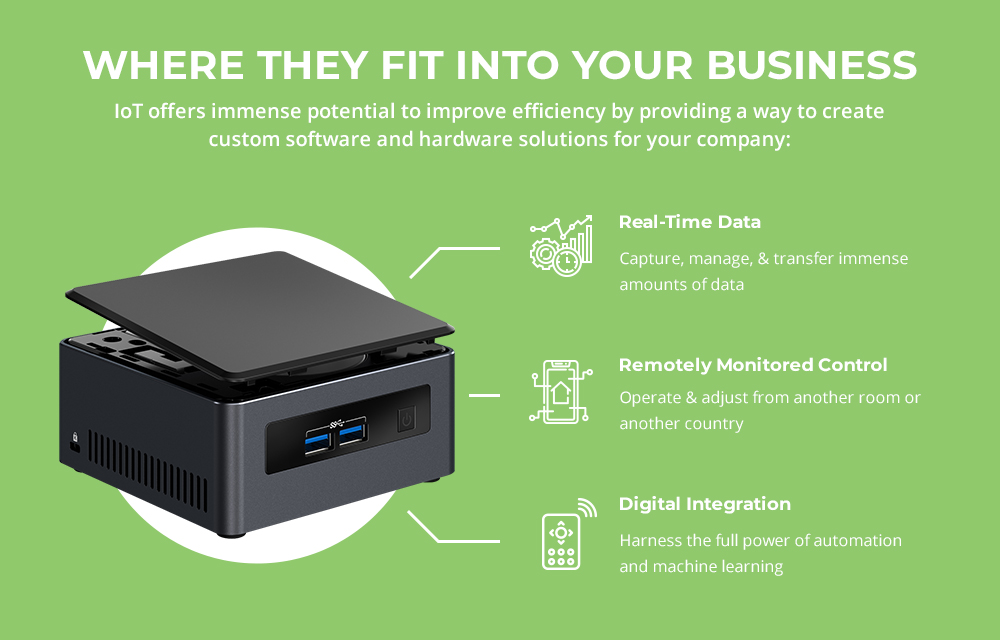You’ve probably heard of it, but do you know what the Internet of Things is? Everything from consumer electronics shows to large manufacturing periodicals tout the many uses of the Internet of Things and the benefits the Internet of Things can bring to your life, but if you want to get the most out of IoT, you’ll need more information and less empty promises before you make an informed decision. Let’s take a look at what it is, and what it can really mean for you.
The Internet of Things
In its simplest form, the Internet of Things is just taking an everyday device, adding a computing element, then providing internet connectivity to it. What the Internet of Things really is, however, is so much more than that. Once connected, functions can be routed through that connection, and carried on the internet to other computers. Depending on the sophistication of the machine, its computer, and the functionalities programmed in, that can mean anything from remote monitoring to remote control of a connected device.
There are so many benefits to the Internet of Things that “sub-categories” have entered common usage. While they may go by specialized monikers like the Industrial Internet of Things or the Medical Internet of Things, their core principles remain the same. Adding connectivity and functionality to more traditional equipment is what the Internet of Things is all about.
Creating an IoT Machine
As with many practical applications of technology, IoT starts with a need. Homeowners have seen rising energy costs leading to a demand for more efficient appliances. Meanwhile, broadband internet access is becoming increasingly common. These two colliding factors were the stimuli for today’s modern “Smart Lights”.
Lights are one of the biggest energy hogs in the house. While more efficient bulbs are helping people save money, a light left on is still wasting electricity. If these lights are connected to the internet and the homeowner has corresponding software on their smartphone, they can turn off lights from anywhere.
That’s a very small, relatively simple application of IoT, but uses for the Internet of Things go significantly farther.
The Internet of Things on a Grander Scale
In a modern factory, a premium is set on uptime and automation. The Internet of Things is what supports increasingly complex machinery.
Using a purpose-built NUC computer, a connected production device sends real-time information back to a central control point. There, a single worker monitors multiple machines. The machinery performs the manufacturing process, beginning to end, taking measurements along the way to verify products fall within parameters. Data is fed back to both the operator running the machine and a record keeping system that monitors and records readings, so the customer gets a uniform product that is in spec. When maintenance is needed, the machine notifies the maintenance department itself, providing real data for troubleshooting and analysis.
With the right engineering and the right computing system, the Internet of Things is what will shape the industry for decades to come.
What You Want in an IoT Machine
You want purpose-built computing power. A purpose-built system takes into account the functionality engineered into your machine, and how that functionality is meant to work with the end user—then it empowers that use with a computer that’s up to the task, such as a NUC. NUCs are ultra-small computers. This small footprint, however, does not translate to diminished capacity. Powered by premium processors, they have the power to enable real-time data and control systems to make automation easier.
Powered by Intel chipsets, our NUCs are highly capable and highly customizable. They can be built to suit systems and software already in place while providing the needed connectivity to explore the full benefits of the Internet of Things. Rather than a one-size-fits-all solution that doesn’t actually work, this tailored approach allows a true IoT capability.

Where They Fit into Your Business
IoT offers immense potential to improve efficiency by providing a way to create custom software and hardware solutions for your company:
- Real-Time Data - Intel NUCs can capture, manage, and transfer an immense amount of data. This can help an operator understand a production machine’s output, a busy nurse monitor a ward full of patients, or just make a home theatre system that much more amazing. There is no practical limit to the sensors that can upload data through a NUC or the platforms it can be linked to in order to communicate that data up the line. The Internet of Things is what NUCs were born for.
- Remotely Monitored Control - Actionable data is great, but the ability to take action using the same pathways is even better. With Intel-powered NUCs, an operator in another room or another country can operate a machine, making adjustments as necessary. This has endless cross-industry applications and allows for experienced, skilled guidance wherever it's needed.
- Digital Integration - NUCs can provide data for human eyes, but they can also let you harness the full power of AI automation and machine learning. Speedy Intel chipsets enable rapid communication. This allows you to fully integrate your IoT machinery into established platforms and processes.
Explore the Benefits for Yourself
Is what the Internet of Things offers right for your company? The only way to find out for sure is to explore it for yourself. Our platforms deploy fast and a two-week demo is usually sufficient for customers to understand the impact IoT can make on their bottom line. Contact us today to speak with one of our experienced specialists. They’ll go over any questions you have, and provide personalized attention to find a solution to your needs. Get the IoT support you need to thrive with EWC Technologies and Intel NUCs.

